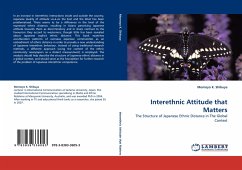In an increase in interethnic interactions inside and outside the country, Japanese duality of attitude vis-à-vis the East and the West has been problematised. There seems to be a difference in the level of the expressed ethnic distance, resulting in Asians perceiving Japanese attitude towards them as discriminatory and in sharp contrast to the favourism they accord to westerners; though little has been revealed about Japanese explicit ethnic distance. This book examines acculturation patterns of overseas Japanese communities as an embodiment of ethnic distance in order to provide a new understanding of Japanese interethnic behaviour. Instead of using traditional research methods, a different approach (using the content of the ethnic community newspapers as a distant measurement) is employed. The analysis should help describe the structure of Japanese ethnic distance in a global context, and should serve as the foundation for further research of the problem of Japanese interethnic competence.
Bitte wählen Sie Ihr Anliegen aus.
Rechnungen
Retourenschein anfordern
Bestellstatus
Storno








